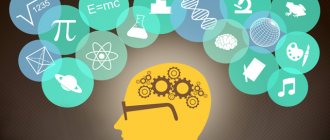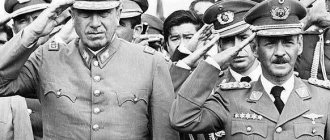If we analyze the work of a modern person with information, we can come to the conclusion that people remember most of the necessary information through repeated repetition, reading, and cramming. This kind of memorization takes a lot of time. There is a special type of memory - figurative memory. It is based on the sensations a person receives from the senses (images).
Images in memory
What it is?
First you need to understand what this type of memory is. Figurative memory is a type of memory as a result of which a person remembers information not in text form, but in the form of images. Most often, these are some pictures, images and other similar memories that are displayed in your head not in words using your inner voice, but in images. That is why this type of memory is very interesting, because images cannot be measured like words, accordingly, this type of memory is much more unusual than the standard memory that every person uses every day. Well, now you understand that figurative memory is a type of memory in which recall occurs through images, that is, some images that remain in your brain.
Visual memory capacity
The volume of visual memory is an important indicator on which the possibility of storing a particular amount of imprinted information depends. To determine the volume of short-term and operative memory, there is the following technique: the child is alternately asked to study two drawings, which are randomly arranged broken lines consisting of 9 segments.
After memorizing each of these two drawings, the child is offered a stencil frame on which he must display as accurately as possible from memory the lines depicted in each of the drawings. Based on two experiments, the average number of lines correctly reproduced from memory is determined.
This indicator is taken as the volume of visual memory. Correct reproduction means a deviation from the original pattern in length by no more than one cell in each line, while maintaining the correct angle of inclination.
Working visual memory shows how long a person can retain and use information necessary to solve a problem. The indicators of a child’s visual operative memory are determined, for example, using the following test: the child is asked to look at cards in the form of six differently shaded triangles for 15 seconds. Then the child receives a matrix of 24 different triangles (4 cards of 6 triangles each) and finds among them those that he memorized on six cards initially. Dividing the amount of time required to solve (in minutes) by the number of errors and adding one, we obtain the desired value - an indicator of the development of visual RAM.
What does she give you?
Many people immediately begin to think about what figurative memory provides, because it seems to them that verbal information is much more important. However, this is far from the case, and now you will understand why. The fact is that the human brain has two hemispheres, each of which is responsible for its own type of perception. The left hemisphere is responsible for processing and remembering verbal information, which is considered by many people to be the only important one, and the right hemisphere is responsible for remembering the images that these words describe. But why are these images needed in memory if only words can describe everything in detail? Everything is not as simple as it may seem, and the clearest example is many children of the current generation. The fact is that the present age is called the information age for a reason: people receive incredible amounts of information from a huge number of sources. Websites on the Internet, advertising on public transport, everywhere you receive information that saturates the left hemisphere of your brain, but the right hemisphere does not receive the corresponding data, that is, images that it could process and use in conjunction with the data of the left hemisphere. The result is a serious imbalance, which causes an increase in attention deficits and absent-mindedness, which most often manifest themselves in young children. To avoid this, it is necessary to develop the right hemisphere, and there is more than one method for this. Figurative memory is very important, and that is why this article will talk about exactly how it can be developed.
Visual memory in children
Even in preschool age, children actively involuntarily memorize words, objects, concepts, images, therefore, during the “child-why” period, it is especially favorable to use special games designed to train visual memory in children. This will prepare the child well for school and will help him perceive complex and voluminous information. Voluntary memory requires effort and the manifestation of attention and will to remember, this also applies to voluntary visual memory. General recommendations for good memorization are:
- What is interesting, bright, and emotionally presented is remembered better.
- The beginning and the end are the most memorable moments.
- What is explained simply and clearly will be remembered better.
- If, in addition to visual, other types of memory were involved (tactile, auditory, motor, etc.), then memorization will be more effective. The most common are mixed types of memory, especially visual-motor or, as it is also called, visual-motor memory.
How to develop figurative memory?
As mentioned earlier, there is more than one method. Figurative memory develops quite easily and without much effort, because the process of memorizing images is natural for humans. Images and textual information add up to a great memory that every person should have, but if your brain is filled with data without images attached to it, then you can easily get confused in that data, so all the capacity of your memory will be effectively useless. Accordingly, it is imperative to develop figurative memory, and the sooner you understand this, the better. Figurative memory develops best in children, since it is in them that it is initially developed very well. It’s just that over time, people begin to rely more on textual rather than figurative information, so they gradually lose the power of this type of memory.
Imaginative thinking and figurative memory are something that every person needs to develop, and this should be done by using all the senses and, accordingly, sources of information in obtaining information. So, the average person simply reads the text or listens to it, it settles in his head and, quite possibly, is forgotten very quickly, even if it is important information. Why? The thing is that he does not have an anchor that would allow him to gain a foothold. Memorizing purely textual information in school and university is called cramming - you simply memorize words in a certain order in order to reproduce them in the same order. But do you remember any of what you crammed in school? Hardly.
But if you use images, which are obtained by attaching certain data to textual information, such as images, sounds, smells, and so on, then you will be able to remember much easier. Accordingly, all you need to do is to constantly use all your senses and try to control the memorization process so that you remember not only the text, but also the images associated with it.
Examples of eidetic memory
Wolfgang Amadeus Mozart had a phenomenal memory. At the age of three, he memorized what his father and sister played, and then reproduced it with precision. There is also a famous case when Mozart was in the Sistine Chapel and memorized a very complex piece. When he got home, he wrote it down. The original sheet music for this piece was kept in a secret place. Upon further comparison of Mozart's recordings and the original, their complete coincidence was established.
Features of figurative memory
Figurative memory has some features that you should know about. The fact is that in most cases it is temporary and the images are stored for about a day. Naturally, if you need specific information, then you can store it in your own brain for a long time, however, so that your brain does not become overloaded with images, it clears itself of that to which requests have not been sent for more than 24 hours. It also turns out that this memory operates on an unconscious level, meaning most of the images are recorded in your brain when they come into your field of vision. This is why many people believe that this type of memory is visual figurative memory. But in fairness, it is worth noting that images can be auditory, tactile, and olfactory, although they are much less common.
If we return to the duration of storage of figurative memory information, then another characteristic emerges here: the longer an image is stored in your brain, the paler it becomes and, accordingly, the more difficult it is for you to remember it in detail.
Long-term, short-term and working memory
Based on the time it takes to store information, we distinguish between instant, short-term, operational and long-term memory. Short-term memory is capable of storing information for a very short time, about 40 seconds, and its volume is small, it is 7 plus or minus 2 units of information. This volume can be increased by combining information into blocks.
Most of the information from short-term memory is then erased, and less goes into the so-called working memory. This is facilitated by some factors, such as the emotionality of the presentation, brightness, surprise, unusualness of the material, repeated repetition, and importance for a particular person. Information is stored in RAM for up to a day (maximum), then the less important part is erased, and the more important part goes into long-term memory. Here, information is stored throughout life, and for this the body uses special nucleic acids and memory proteins.
Interestingly, in the slow-wave sleep phase, logical information processing occurs, and in the fast sleep phase, selected information is transferred to long-term memory. You can read more about these processes and the development of long-term memory, as well as the development of short-term memory, in our blog.
Fading images
What this is cannot be demonstrated clearly. Figurative memory is an abstract concept and all processes occur in your brain, but it is quite possible to describe what it is. So, imagine that you are traveling on public transport during the day. Returning home, you remember that you saw a woman in a blue coat, she was sitting next to you. At this point, you may remember other details such as the color of her hair, her facial features, the accessories she wore, and so on. But if you don’t think about it for at least a day, then the next day you will have difficulty remembering those details that seemed obvious to you yesterday. What can we say about what will happen in a week or month. Figurative memory is different in that the images stored in the brain become pale and fuzzy over time. They are unstable and may be fragmentary. For example, in a month you will forget what the girl was wearing in principle, but the earrings that she wore then will be imprinted in your brain. And of course, it is worth noting that each image can deceptively change over time and after a month it may seem to you that the girl was wearing a green coat, although in fact she was wearing a blue one. This is explained by the fact that it is easier for the human consciousness to create something new to replace the lost element of the image than to waste energy on remembering this element.
Famous people with eidetic memory
History knows many examples of people with innate or acquired eidetic memory. Here are just a few of them:
- T. Roosevelt. Every day I trained my memory and read three books.
- N. Tesla. Since childhood, he had a phenomenal memory.
- John Paul II. Knew 21 languages and 100 dialects.
- Kim Peak. A simple, but at the same time unusual resident of America. Kim read two pages in parallel and immediately remembered what he read.
- Ferdinand Marcos. He memorized, reproduced or retold text of any complexity and volume.
- Julius Caesar. He had an excellent memory for faces and knew all the soldiers.
- Meryl Henner. Another ordinary, but unique American resident who remembered her entire childhood in detail.
- Mary Elizabeth Bowser. A legendary intelligence officer who memorized and accurately conveyed all the information she learned.
When does imagery appear?
The development of figurative memory is something that every person should think about. And as mentioned earlier, this should be done as soon as possible. However, when exactly does a person develop figurative perception and, accordingly, figurative memory? You may be surprised, but a person’s figurative memory appears only at one and a half to two years, that is, quite late. It is then that the child’s brain begins to perceive the phenomena of the surrounding world not just as phenomena, but as information that can be recorded. It is then that concepts begin to accumulate in his brain at tremendous speed, which are accompanied by images, as a result of which memory is formed. Then the child gets the opportunity to independently build logical chains, connecting the concept with the image.
Why is it necessary to develop figurative memory from early childhood? Many parents believe that this is an unnecessary process and the child needs to concentrate on concrete concepts, and not on abstract images. However, this is a big mistake, because figurative memory is often called the foundation of all memorization processes. Without it, the memorization process will not be complete, and if it is poorly developed, then the person’s memory will be very poor. Accordingly, the development of imaginative thinking is one of the important steps towards the formation of a full-fledged personality that can function in the modern world.
Visual memory impairment
As a rule, memory impairments are associated with stress, overwork, and they can also be a consequence of somatic diseases. Alcoholism is scary because it affects the liver and leads to hypovitaminosis. In addition, alcoholism affects brain structures. Memory impairment is also caused by cerebral circulatory disorders, cerebral vascular spasms, and age-related changes.
Visual memory disorders are associated primarily with trauma or tumor processes, which primarily affect the occipital zones of the cerebral cortex. This is expressed in a disorder of visual perception and difficulty in recognizing objects and objects perceived before, or if, when recognizing and understanding the purpose of an object, there are difficulties in naming it.
In some cases, insufficient development of visual memory may be associated with insufficient maturity of certain neural structures of the brain or visual analyzers in childhood and adolescence, or diseases and disorders of these structures. In this case, to study visual memory, taking into account specific nuances, you need to consult a medical specialist (neurologist, ophthalmologist, neuropsychologist).
Types of figurative memory
Psychologists often highlight certain types of this memory, which you should also familiarize yourself with. Naturally, as you most likely guessed, visual memory is the most famous, because visual images occupy the largest amount of memory, they are the most detailed, and they are the ones you most often rely on when trying to remember something. But there are also other types that are no less important, although they are used a little less often. The types of figurative memory include auditory, tactile, gustatory and olfactory, that is, those that correspond to a specific sense organ. Accordingly, all the sound images that you have in your head, that is, the song that you heard on the subway, or the slogan that came to your ears from the loudspeaker, belong to auditory figurative memory. The same applies to other types of memory, which were mentioned above.
Photographic memory
As you have already learned, figurative memory includes any memory associated with the senses, since all such information does not come in the form of specific data, but in the form of abstract images. But at the same time, I would like to separately highlight photographic memory, which most likely every person has heard about.
Photographic memory is a subtype of visual figurative memory, but is distinguished by its incredible detail, which is unusual for most people, and the complete absence of pallor and clarity. What does it mean? Imagine how figurative memory works, it was described above. You look at an object and your brain takes a “snapshot” of that object, recording it in your brain. But this photo is initially blurry, and you are unlikely to be able to see all the details in it to reproduce them. If you have a photographic memory, then your brain can take perfect pictures that you can store for a long time without any loss in quality. Naturally, every person would like to have a photographic memory, however, given the fact that many parents do not strive to develop figurative memory in children, and also do not develop their own memory, this concept is now perceived more as a phenomenon than as something to what you can strive for and what you can achieve. But in reality this is not so, and you can independently change the order of things.
Diagnostics of visual memory
To diagnose visual memory in children at home, you can use, for example, a technique called “Ten Pictures”. To do this, prepare a sheet with small pictures of objects or animals pasted on it. You can use drawings instead of pictures, but they must be recognizable. Let your child study the pictures for 50 seconds (alternatively, you can use individual pictures, in which case each should be looked at for 5 seconds).
Then take the piece of paper and ask them to name all the images from memory. The order doesn't matter. This tests short-term visual memory. If a child remembers at least 8 images, this is an indicator of good visual memory. From 4 to 7 images is medium, and 3 or less is low. This test can also be used to determine the volume of visual memory. We’ll tell you how below.
Workout
You can independently influence how developed your figurative memory is, even if your parents did not pay much attention to it as a child. To do this, you need to conduct daily training that will allow you to better remember images. How to do it? You need to memorize various images and then reproduce them. Exercises can be very varied. For example, it could be a series of pictures that you need to look at and remember the images, rather than trying to come up with verbal associations. Then you need to reproduce the order of these images. You can also memorize a picture and then try to reproduce as many details as possible. There are a wide variety of games that involve memorizing images, so this can also help you, and photographic memory may soon seem no longer an unattainable phenomenon.
Visual memory games
You can help your preschool child develop good visual memory and at the same time train or test your own. We offer several games for visual memory:
Name the picture
Prepare 10-12 pictures, place them on the table and look at them with your child for 1 minute. Then hide or cover the pictures and take turns with your child to name one at a time, without repeating. The one who cannot name the remaining picture will lose.
What changed?
Prepare about 8 small items or toys. A pencil, a pen, an eraser, a block of plasticine, a typewriter, a hairpin, a coin, a button, etc. will do. Place the objects on the tray, let the child look for 40 seconds, ask him to turn away and change something (remove, add or change the arrangement of objects). So what has changed? Swap places with your child, now it’s your turn.
Draw from memory
Prepare several sheets of paper and a pencil. On one sheet of paper, draw a simple figure or pattern, show it to the child for 20-30 seconds, remove it, and ask him to draw from memory. See what happened together. Now you.
Games to develop visual memory can become a useful habit, a part of life, as natural and integral as exercise or washing your face. And you will learn to notice details, instantly “grab” them and retain them in memory. In addition, exercises for developing visual memory can become a favorite joint activity with children. Don’t be upset if something doesn’t work out right away: behind any achievement there is hard work. But it is in your power to make it exciting, turn it into a game, and fall in love with it.
We sincerely wish you success in self-development!











